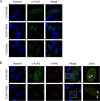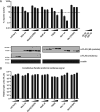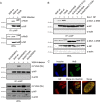Subcellular Localization of MxB Determines Its Antiviral Potential against Influenza A Virus
- PMID: 32907985
- PMCID: PMC7592211
- DOI: 10.1128/JVI.00125-20
Subcellular Localization of MxB Determines Its Antiviral Potential against Influenza A Virus
Abstract
Mx proteins are interferon (IFN) type I (α/β)- and type III (λ)-induced effector proteins with intrinsic antiviral activity. Mammalian Mx proteins show different subcellular localizations and distinct yet partially overlapping viral specificities. However, the precise mechanism(s) of antiviral action are still unresolved. Human MxA accumulates in the cytoplasm and inhibits a wide variety of RNA and DNA viruses, among them influenza A virus (IAV). In contrast, MxB, the second human Mx protein, localizes via its amino (N) terminus to the outer nuclear membrane at or near nuclear pores and inhibits the nuclear import of incoming human immunodeficiency viruses (HIV) and herpesviruses, but not that of IAV. Here, we evaluated whether the antiviral specificity of MxB is determined by its subcellular localization. For this purpose, we redirected MxB to the nucleus or cytoplasm by either attaching a nuclear localization signal to its N terminus or by exchanging the N terminus of MxB with that of MxA. Interestingly, ectopic expression of these MxB variants in the nucleus or in the cytoplasm rendered the host cells resistant to IAV, revealing that the capacity of MxB to block IAV replication critically depends on the site where the protein accumulates in the infected cell. Furthermore, coimmunoprecipitation (co-IP) assays demonstrated that MxB physically interacted with the nucleoprotein (NP) of IAV. Taken together, the data indicate that the subcellular localization of the MxB protein plays a pivotal role in determining its antiviral specificity.IMPORTANCE The interferon system plays a pivotal role in the defense against viral infections. The dynamin-related Mx proteins form a small family of interferon-induced effector proteins with distinct antiviral specificities and subcellular localizations. So far, it is not clear whether the different virus specificities of Mx proteins are the result of distinct mechanisms of action or are due rather to their different subcellular localization. We show here that the human MxB protein, normally localized to the outer membrane of the cell nucleus, acquires antiviral activity against IAV when redirected to the nucleus or cytoplasm, subcellular sites where other members of the Mx protein family efficiently interfere with IAV replication. Our findings thus strongly suggest that Mx proteins act primarily through a common mechanism and that their viral specificity is at least in part determined by their individual subcellular localization.
Keywords: Mx proteins; MxB; influenza A viruses; interferon system; subcellular localization; viral specificity.
Copyright © 2020 Steiner and Pavlovic.
Figures






Similar articles
-
Interferon-induced antiviral protein MxA interacts with the cellular RNA helicases UAP56 and URH49.J Biol Chem. 2011 Oct 7;286(40):34743-51. doi: 10.1074/jbc.M111.251843. Epub 2011 Aug 22. J Biol Chem. 2011. PMID: 21859714 Free PMC article.
-
Host and viral determinants for MxB restriction of HIV-1 infection.Retrovirology. 2014 Oct 25;11:90. doi: 10.1186/s12977-014-0090-z. Retrovirology. 2014. PMID: 25348155 Free PMC article.
-
Pro-515 of the dynamin-like GTPase MxB contributes to HIV-1 inhibition by regulating MxB oligomerization and binding to HIV-1 capsid.J Biol Chem. 2020 May 8;295(19):6447-6456. doi: 10.1074/jbc.RA119.012439. Epub 2020 Mar 26. J Biol Chem. 2020. PMID: 32217692 Free PMC article.
-
Interferon-induced Mx proteins in antiviral host defense.Biochimie. 2007 Jun-Jul;89(6-7):812-8. doi: 10.1016/j.biochi.2007.04.015. Epub 2007 May 8. Biochimie. 2007. PMID: 17570575 Review.
-
Human MX2/MxB: a Potent Interferon-Induced Postentry Inhibitor of Herpesviruses and HIV-1.J Virol. 2018 Nov 27;92(24):e00709-18. doi: 10.1128/JVI.00709-18. Print 2018 Dec 15. J Virol. 2018. PMID: 30258007 Free PMC article. Review.
Cited by
-
Oral Antiviral Defense: Saliva- and Beverage-like Hypotonicity Dynamically Regulate Formation of Membraneless Biomolecular Condensates of Antiviral Human MxA in Oral Epithelial Cells.Cells. 2024 Mar 28;13(7):590. doi: 10.3390/cells13070590. Cells. 2024. PMID: 38607029 Free PMC article.
-
MxB Disrupts Hepatitis C Virus NS5A-CypA Complex: Insights From a Combined Theoretical and Experimental Approach.Front Microbiol. 2022 Mar 17;13:849084. doi: 10.3389/fmicb.2022.849084. eCollection 2022. Front Microbiol. 2022. PMID: 35369502 Free PMC article.
-
Rapid Reversible Osmoregulation of Cytoplasmic Biomolecular Condensates of Human Interferon-α-Induced Antiviral MxA GTPase.Int J Mol Sci. 2022 Oct 22;23(21):12739. doi: 10.3390/ijms232112739. Int J Mol Sci. 2022. PMID: 36361529 Free PMC article.
-
Restriction factor screening identifies RABGAP1L-mediated disruption of endocytosis as a host antiviral defense.Cell Rep. 2022 Mar 22;38(12):110549. doi: 10.1016/j.celrep.2022.110549. Cell Rep. 2022. PMID: 35320721 Free PMC article.
-
Temperature and WNK-SPAK/OSR1 Kinases Dynamically Regulate Antiviral Human GFP-MxA Biomolecular Condensates in Oral Cancer Cells.Cells. 2025 Jun 20;14(13):947. doi: 10.3390/cells14130947. Cells. 2025. PMID: 40643468 Free PMC article.
References
Publication types
MeSH terms
Substances
LinkOut - more resources
Full Text Sources
Miscellaneous

